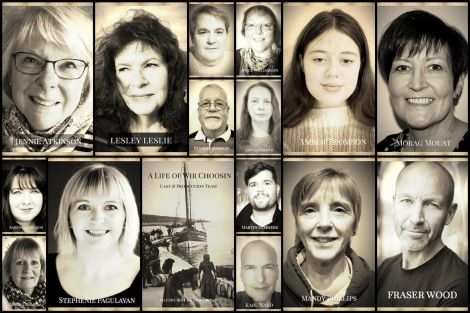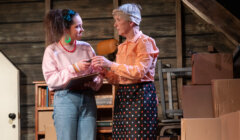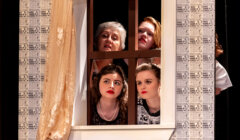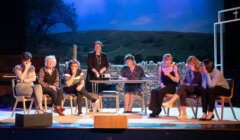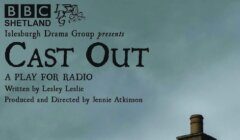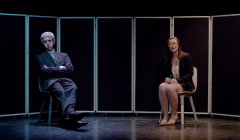Reviews / Innovative theatre at a time curtains are still down and doors closed
Helen Kerr reviews A Life of Wir Choosin, performed by Islesburgh Drama Group, written by Lesley Leslie, directed and produced by Jennie Atkinson and presented as part of Shetland Arts’ Refresh Now programme on 23 April.
I LOVE the theatre. I love plays, musical theatre, innovations in theatre that push the boundaries, street theatre – I’ve seen theatre in castle grounds and in pokey drama studios, I’ve been to Broadway and the West End and I’ve seen productions in crumbling cathedrals. I love the spectacle and the experience: the lights, the stage, the majestic auditoriums…and I’ll always love those things.
But theatres across the country are still dark. Curtains down, doors closed. No lights, no spectacle. Definitely no crowds. My heart aches at the thought of social distancing at the theatre when part of the buzz is being part of a packed audience.
So I take my proverbial hat off to Islesburgh Drama Group’s consistent and persistent desire to bring theatre – one way or the other – to an audience. No crowd, no spectacle. No lights or curtains. No interval with a tub of ice cream – unless you meander to your own freezer half way through.
But what I have really felt reminded of over these past productions – and A Life of Wir Choosin is no exception – is that the physical performance is only part of it all. Robust characters, well-paced dialogue, glimpses into bygone days and private lives…these are just as much the essence of theatre as anything.
Following the story of the well-to-do English girl – Emily (played by Stephanie Pagulayan) and her friendship with Shetland gutty lass – Chrissy (played by Morag Mouat), A Life of Wir Choosin gives us a (too brief) snapshot into two women at the turn of the previous century.
It is in chunks – we start with the two women meeting in Yarmouth, England. An unlikely pair and an unlikely friendship. The astute Chrissy recognises easily that Emily, as much as she tried to hide it, is in an abusive marriage, trapped in her social class and the hierarchical structures that came with it.
Become a member of Shetland News
Pagulayan’s portrayal of Emily was sensitive and warm and her earnest attempt to sustain an English accent was commendable. Chrissy, the Shetland lass with the broad local accent who found herself knapping often in order to make herself understood by Emily, was equally warm, but in her voice was the apparent feisty, gutsy edge you might expect of a woman whose life was spent gutting herrings.
Their friendship reveals many of the issues women faced in those days. Social structures and women’s choices become major themes, in particular how these often worked against them.
Both women face different trials: Emily has money but needs to escape her violent husband, whereas Chrissy lives a life of community, hard work and laughter, but has no prospect of becoming anything other than a gutty lass.
As with the other short radio plays produced by Islesburgh Drama Group, the scenes have pace and are punctuated with bursts of music – in this case largely the fiddle and accordion. This enables the listener to adjust to either a change in location or the passage of time; sound effects were well used to mark outdoor areas and crowds.
Of all the radio plays, I felt this one got this really right; enough sound effects to create atmosphere and location without feeling too contrived. The music set the mood beautifully and anchored it firmly in Shetland’s rich fishing and musical heritage.
The cast also felt a little more ambitious; the voices were distinct and well-characterised – particularly Mandy Phillips’ portrayal of Lizzie – who seems suspicious and jealous of Emily as she gossips about her, but later softens as Emily integrates into the community, even teaching Lizzie to read and write.
This production’s biggest addition, however, was the backdrop of photographs to the audio. In an interview with BBC Radio Shetland, writer Lesley Leslie explained how she wanted this to be a “community project” in that it gathered local artists across writing, acting, music and photography.
The historic photos of Shetland were fantastic; while there are no doubt many locals who will know something or other of the fishing, the visual dimension meant that you could draw conclusions about what these women were like, their communities and their workplaces.
I was, I have to confess, less persuaded by those photos that were to depict Emily’s English backdrop – lovely photos, sure, but nowhere near as mesmerising as those of the gutty lasses of days gone by.
I look forward to what is next for Islesburgh Drama Group, who keep pushing to make innovative and accessible theatre. While I hope sincerely for the day when auditoriums are packed once more with the spectacle and the audience, I hope also that this new segue into audio productions lasts and grows from strength to strength.
Become a member of Shetland News
Shetland News is asking its readers to consider paying for membership to get additional perks:
- Removal of third-party ads;
- Bookmark posts to read later;
- Exclusive curated weekly newsletter;
- Hide membership messages;
- Comments open for discussion.
If you appreciate what we do and feel strongly about impartial local journalism, then please become a member of Shetland News by either making a single payment, or setting up a monthly, quarterly or yearly subscription.






























